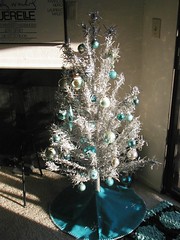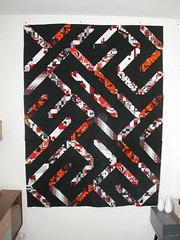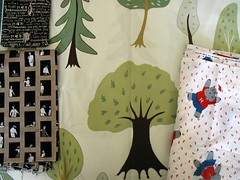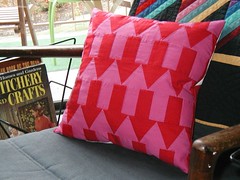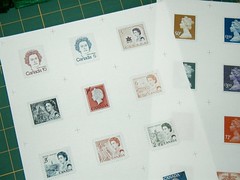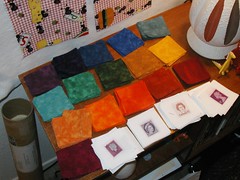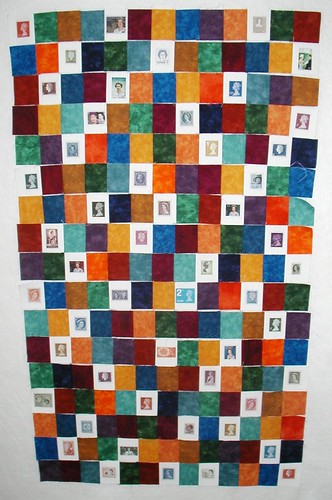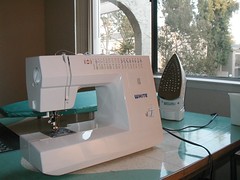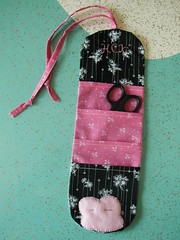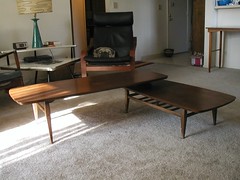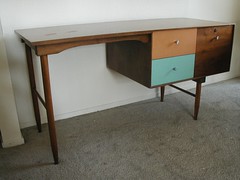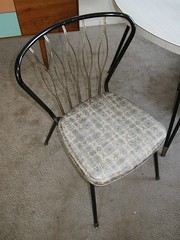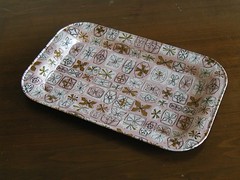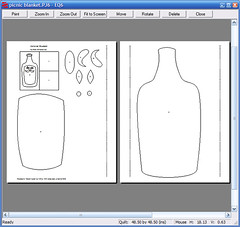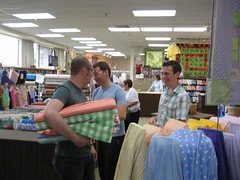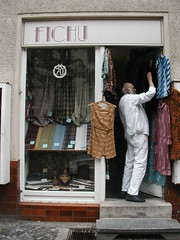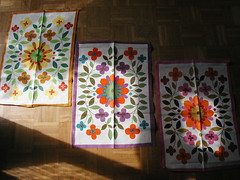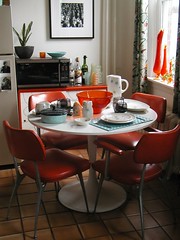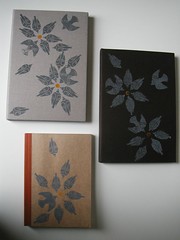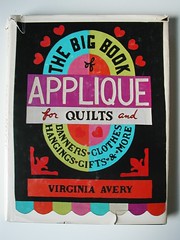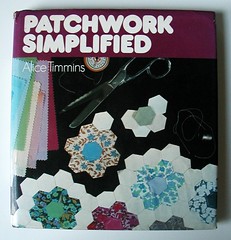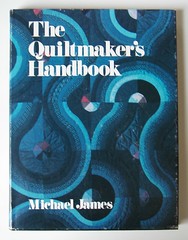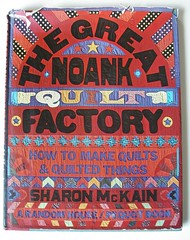Tuesday, December 18, 2007
Getting ready for Christmas
With the last few work projects heading out the door, I'm scrambling to get everything else ready in time for the holidays. The tree, though, has been up for a while, displaying ornaments plucked from thrift and antique shops by the Other, the Mother, and me. I think the Other considers my colour coordination of the tree a little fascist. I can live with that.
Friday, December 07, 2007
Slash/Backslash quilt top
I should probably be devoting all sewing time to Christmas presents, but I was feeling the quilting bug and threw this top together. It's another one I designed a while ago. I'm pretty much over the colours, but it used up fabric I'd been gathering to go with Plain Spoken and Day at the Beach.
Piecing the triangles wasn't as scary as I'd been led to believe—the hardest part was working out the math so I could sew squares (and then slice 'em apart afterwards) rather than actual triangles. Oddly enough, I found it much easier to match the points on opposing 45-degree angles than I did on the perpendicular lines. I'm quite looking forward to putting my walking foot to use with the quilting, now that I've finally got one.
So now, thanks to a coupon from Jo-Ann.com, I'm off for a half-off batting....
Tuesday, December 04, 2007
January/Febrary Quilter's Home out
 The latest issue of Quilter's Home has been spotted in the wild, so head to your local quilt shop if you'd like to check out my article on killing off lingering UFOs. I'm looking forward to reading about Quiltzillas, McQuilters, and other characters from quiltland....
The latest issue of Quilter's Home has been spotted in the wild, so head to your local quilt shop if you'd like to check out my article on killing off lingering UFOs. I'm looking forward to reading about Quiltzillas, McQuilters, and other characters from quiltland....Update: And thanks to Whip Up for featuring my Transport pillow in their recent What's Quilting post!
Wednesday, November 21, 2007
Christmas comes early
Are those taper legs? Yes! Is the stain a perfect match for this desk? Yes! Is the sewing machine that retro shade of aqua that I find so luscious? A thousand times yes!
While the table's not crucial furniture, I think I can modify the table to fit Gertrude, my more modern sewing machine, which would give me a nice flat surface. Gertrude's no looker, but she probably has to stay my workhorse machine.
On the other hand, the old Singer seems to work—I need to play with it a bit more—and it has such a big throat that I wonder if it might prove useful as well as lovely. And even if lovely turns out to be the Singer's only real quality, I think she's mighty cute.
So now I'm off to scour the Internet for a manual, clean her up a bit, and see what she can do.
My first quilt show (sort of)
I stupidly didn't take any pictures of the impressive quilts there, so you'll have to ogle the fabric I bought instead, most of it secondhand and cheap to counter the expensive tree fabric imported from Japan. Haven't a clue what I'll do with it yet, but I have a friend who'd love something from the hippo fabric.
We didn't know that men got free admission to the show, so that was a nice bonus. The usual surprise at men in quiltland popped up again, with one woman sarcastically saying, "Oh, yeah, I bet you're thrilled" as I dug through a pile of old embroidery. Little did she know that I might as well have been in a candy shop. I may look like a twentysomething man (actually, my hairline adds a few unwarranted years), but really I'm just a little old lady like the rest of them.
Plenty of the women there asked me about my quilting, and a couple even begged me to join their guild. Since the Other and I just (finally) bought a car, extending our mobility past the mailbox on the corner, I could actually go to meetings. But I dunno. I probably won't be bothered with blocks of the month and that sort of thing, as I pretty much know what kind of quilts I like working on, aesthetically speaking. And will they recognize my inner old lady or think I'm just a very strange little man? Anybody out there want to enlighten me on the joys of guild membership?
Monday, November 12, 2007
Transport pillow
Ah, pillows. A while ago I proclaimed that every quilt should receive a coordinating pillow, but this time I went straight to pillow to test a design inspired by a Swedish train's upholstery (moquette to those in the know), glimpsed in a controversial post here. They were on about the embroidered graffiti, but I was more interested in the pattern underneath. You can add rail upholstery to my list of geeky interests—there was a time when I could identify London Underground lines based on a glimpse of moquette . When I was back in London last summer, one of the saddest things was discovering that some of the Tube trains had been reupholstered, sending my recognition skills the way of Strand Station (ruck, ruck, ruck; pretend you found my obscure Underground humour amusing).
Anyway, back to the matter at hand. I made a quilt design based on the train in EQ6 and scaled it down to pillow size for a test run. Of course, I probably should have practiced half-square triangles before jumping into the strips of equilateral triangles—stretchy, stretchy, stretchy. And somehow my carefully planned dimensions still needed some yanking and pinning under duress when it came to sewing the rows together. So the pattern still needs some perfecting.
All along I had planned to outline quilt the arrows by hand to reinforce their shape, but at the last minute I decided to just stitch in the ditch. The original plan probably would have looked better and been easier to quilt. But as a design test, I think the project worked out nicely. The simple pattern and colour scheme make it both easy and modern, so I'll probably try a larger version with bigger blocks someday.
Since I was just testing things out, I wanted to keep the pillow cheap. The only thing bought new was the pillow form (and that half off). The red fabric was left from Plain Spoken, the pink fabric and thread from my flamingo quilt, the batting from Card Catalog, and the backing from some makeshift curtains I had in my skanky London bedsit. If I showed you pictures of the place, you'd know why I was more interested in the Tube trains.
Wednesday, November 07, 2007
Publications
 In the furor of sewing curtains, pillows, and other household stuff for the new apartment, I forgot to mention that I've got an article in the current issue of Quilter's Home magazine! It's about putting your fabric stash on a diet. Editor Mark Lipinski does a great job with this fun magazine, so check it out if you haven't already.
In the furor of sewing curtains, pillows, and other household stuff for the new apartment, I forgot to mention that I've got an article in the current issue of Quilter's Home magazine! It's about putting your fabric stash on a diet. Editor Mark Lipinski does a great job with this fun magazine, so check it out if you haven't already.Also, Natalie at Craftzine.com just posted on my Card Catalog Quilt—take a look!
Friday, November 02, 2007
Sewing-room saviour: pegboard!
Having a space to house all my sewing and quilting supplies continues to delight, particularly with the recent addition of a pegboard. Simply getting quilting rulers out from under foot was enough to make me fall in love, and I've always had an affection for modular and reconfigurable storage. Plus, the board's silvery colour was a perfect match for the magnetic panels I have over my desk on the other side of the room. If you're interested, click the photo above for some labels. A few highlights that make me especially giddy:
- The pencil holder, built specifically for pegboards, has a built-in pencil sharpener! Perfect for fabric-marking pencils, since my sharpener always seems to go walkabout.
- I've always wanted plug sockets up high on the wall so I don't have to bend down to plug in my iron all the time. Now I've got 'em, and I can use the strip on the pegboard for a lightbox, hot glue gun, or anything else I might need near my cutting table.
- ReadyMade number 29 had some pegboard ideas, including the curtain-rod rail I've used here. They suggested it for tape, ribbon, and wire, but it's also a great place to keep that perennial quilters' favourite, freezer paper.
Her Majesty's Stamp Collection
The stamp images come from several Commonwealth countries, particularly the UK and Canada. I chose the texture colours based on the common colours of Queen's head stamps.
Thursday, October 18, 2007
Tutorial: cover for Ikea ironing board
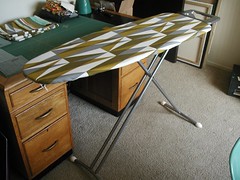
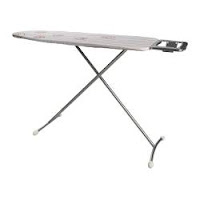 Given the disastrous death of my previous ironing board, a replacement was necessary. But Ikea's Dänka comes with the gross scribbly flower cover shown at left, which would clearly be bullied by the other decor of my burgeoning sewing room/office. So using some green and grey Pernilla fabric that will match the eventual curtains, I threw together a simple new cover using the existing one as a pattern. Here's how, in case anybody else is similarly turned off by the default cover. (And trust me! The steps look long, but it really is pretty simple.)
Given the disastrous death of my previous ironing board, a replacement was necessary. But Ikea's Dänka comes with the gross scribbly flower cover shown at left, which would clearly be bullied by the other decor of my burgeoning sewing room/office. So using some green and grey Pernilla fabric that will match the eventual curtains, I threw together a simple new cover using the existing one as a pattern. Here's how, in case anybody else is similarly turned off by the default cover. (And trust me! The steps look long, but it really is pretty simple.)Materials:
- Dänka ironing board
- 1 1/2 yds (1.5m) cotton fabric, such as Pernilla (there will be lots of excess, but if the pattern runs up the bolt, you'll need this much)
- Straight pins
- Clear acrylic ruler
- Pencil or fabric chalk (a regular pencil is fine; the marks will be hidden in the seam allowance)
- Scissors
- Sewing machine
- Thread
- Safety pin
Instructions:
- Untie the string holding the cover to the ironing board. Pull the string out of the cover and set the string aside. Remove the cover from the board, leaving the padding in place.
- Use the old cover as a pattern for the new one: Place the cover flat on the right side of the fabric, allowing 1 inch (2.5cm) all the way around for seams. Pin the cover to the fabric every few inches along the perimeter, smoothing the cover as you go to keep it flat.
- Mark the seam allowance around the old cover: Use the ruler and pencil or chalk to mark 1 inch (2.5cm) from the old cover all the way around the "pattern". When turning corners, make short marks and move the ruler frequently.
- Cut the fabric out along the marked line. Do not unpin it from the old cover.
- Turn the old cover and fabric over so the wrong side of the fabric faces you. Snip into the seam allowance, almost 1 inch (2.5cm), at the tip of the arm (at the same place where the string ends came out of the old cover). Zigzag stitch along the edges and end of the snip to prevent fraying.
- Fold a double hem for the cord channel: Remove a pin and fold 1/2 inch (1.25cm) of the fabric edge in, then fold that edge in another 1/2 inch (1.25cm). The outside fold should line up with the edge of the old cover beneath. Repin the hem, catching only the new fabric. Repeat around the perimeter of the cover. There will be extra fabric bulk in the curves or the seam allowance—a pro seamstress/seamster would make them nice and neat, but since the channel gets cinched by the cord anyway, I just flattened out the folds as best I could. Chuck out the nasty old cover or save it for future pattern use.
- Sew the channel: Starting and the snip made in Step 5, sew a straight stitch close to the fold of the hem, removing pins as you go. Adjust the bulk around curves as necessary.
- Insert the cord: Tie the string to the safety pin. Insert the pin into one end of the channel and work it through to the other end. You'll periodically need to slide the cinches onto the loose end of the string. When finished, you should have a roughly equal amount of string on each side of the channel opening.
- Fit the new cover around the board: Place the cover on the ironing board, keeping the padding that came with the board in place. If the cover got wrinkled when inserting the string, iron it now. Use something flat to push the end of the cover through the small space between the end of the board and the iron holder. Arrange the cover so there is a roughly even amount of material around all the edges, again making sure the padding stays in place. Pull the string to cinch the cover around the board. Tie the ends of the string a few times to secure.
All the pinning and whatnot takes some time, but the finished product will make me much less cranky while ironing.
If you're looking to sew a completely new cover (that is, with fresh padding and everything), try the instructions on The Purl Bee.
Sunday, October 07, 2007
Traverse rods: can't live with 'em, can't live without 'em
Here are the Other's lovely curtain panels, which we hung up yesterday over the sliding glass door in our living room. A little hard to photograph with light filtering through, but they're an immense improvement over the bog-standard vertical blinds inflicted upon us by the apartment complex. Would you believe he only paid $50 for seven floor-length panels? Not if you've ever priced midcentury textiles, you wouldn't.
The traverse rod instructions said installation would take 30 minutes, but it was more like the whole afternoon. Said instructions were virtually useless, and the instrux on the Home Despot website were only a little better—they were supposed to be for the same SKU, but they were clearly for a slightly different rod. (Plastic gates? What effing plastic gates?!)
Tuesday, October 02, 2007
One more move finished
I've already moved across the country this year; last week it was time to move just round the corner to a slightly bigger apartment. When my worldly possessions come out of storage on October 9, I'll finally be settled! Until then, my fabric supply remains low, so quilting updates will be few.
Saturday, September 15, 2007
Happy birthday to the Mother!
The "sewing roll" pattern comes from here. I picked up the black-on-white fabric for the Mother in Berlin, and the pink and black fabrics came from the local quilt shop I've been delighted to find here in our crummy corner of California.
I just picked the colours 'cause I thought she'd think they were fun, but it turns out she's been working on some bigger bags in the same colours. The Father's always thought the Mother and I had a creepily direct link to each other's brains...
Happy birthday, The Mother! Lots of love from your Feed Dog.
Monday, September 10, 2007
If I weren't me, I'd be jealous of me
On a whim, the Other suggested we pop into a usually fruitless Goodwill yesterday. And look what we found! This saucy little coffee table is made of two pieces, joined with a peg, so that the lower surface can swing all the way around to make an L shape or a long table. Or it can be tucked underneath to save space and make a nice shelf for magazines and remote controls.
But that's not all! As we were rushing to get the table safely in our clutches, we spied one of the loveliest midcentury desks I've ever seen...
My apartment has always featured aqua and orange, so could it be more perfect? I'm criminally infatuated. The price tag left marks on the top, so I may need to refinish it, but the Other and I are already fighting over who gets to occupy the desk. Since I'm working from home now, it's obviously going to be me. (I shall have the most beautiful office/sewing room in all the land!) Felis Domesticus (that is, the Other's cat) has staked her own claim, basking on the desktop before the dust had even settled. She does know how to push my buttons—and she knows bloody well I can't spritz her with the water bottle if she's near delicate wood surfaces.
The cost for these two pieces? Less than $50 for the pair. (Plus taxi fare to haul the desk down the street—we looked ridiculous enough shuttling the table home on foot.) And both were pieces of furniture we kind of needed.
But that's still not all! The Other's had a set of dining chairs like this for a while:
Good, eh? I've always loved the pattern on the vinyl seats (click the photo for a closer look). Lo and behold, what did we find at an antique shop on Saturday?
Same pattern! Different colours, but given the Other's appreciation of flamingos and the like, the pink was perfect. There was a pair of the trays, so naturally we took them both home. Anybody know anything about the pattern's provenance?
We're probably moving apartments soon, so things aren't quite settled, but we're getting there. And I'm delighted to have a partner in crime to salivate over bargainous furniture with. (Watch for edits to the previous sentence
Thursday, September 06, 2007
EQ6 Workaround: Save Appliqué or Piecing Templates
The background for this block I designed for a picnic blanket is pieced; I can rotary cut the rectangles, so I don't need templates for them. I got rid of them and nudged the other pieces around until everything fit on two pages (EQ6 still showed a third blank page, but it doesn't print the blanks):
So far so good. But to print the templates again, I'd have to start with the original layout. EQ6 doesn't offer a way to save templates, but here's a workaround to do just that. As an added benefit, your templates will be universally accessible, even to people who don’t have EQ. Really, it's just printing a PDF.
-
Make sure your computer has a PDF printer driver installed. I use CutePDF. Macs usually let you save a PDF directly from the print dialogue, but if you had a Mac, you wouldn’t be using EQ6, would you? (That is, unless you were some kind of Parallels wizard.)
-
Tell EQ6 to print your templates (File | Print | Templates). Double check that the settings (line width, key block, etc.) are how you want them.
-
Click the Page Setup button, then click the Printer button. Choose the PDF printer.
-
Back on the Print Template screen, press the Preview button. Arrange your templates how you like, rotating, moving, and deleting patches as necessary (click the buttons along the top, then click the patch you want to change. For deleting, you’ll need to press the Delete key on the keyboard when the patch is highlighted). Make sure to leave an adequate margin around the edge of the page—the PDF might fit everything fine, but the printer it ultimately sends to may not.
-
Press Print. When the PDF driver prompts for a file name, choose a folder, name the file, and hit OK.
-
When you print templates from the PDF, make sure the pages print at 100%—that is, without any page scaling. Adobe Reader often defaults to scale everything down to the printer margins, but you don’t want that here. There’s a drop-down on the Print dialog box to set it right.
These templates are all set for e-mailing to a friend, taking to the copy shop, or whatever.
EQ6 does have some frustrations, but it certainly makes quilting easier. Give it a go...
Friday, August 31, 2007
Youngest Brother reveals freakish grasp of fabric industry
The wedding brought nearly every relation I have out of the woodwork (one wonders what was left of the woodwork, in fact), but more relevant to the topic at hand was the Mother and I dragging Middle and Youngest Brother to a quilt shop while waiting for the Other's plane. It was a pretty good shop, with 15% off their vast array of cottons.
While I stacked bolts under my arm, Youngest Brother proved that I am not the only male in the family to have developed an appreciation of fabric. The Mother was on the hunt for pre-Civil War reproduction prints, a new territory for her, and Youngest Brother spotted one he thought she would like. “It looks like the Jane Austen Collection,” he suggested, and the Mother and I burst into laughter at the thought that he was even aware of there being specific fabric lines, much less that he could name one, much less that he could aesthetically categorize a stray fat quarter. We unfurled the chunk to discover that, yes, in fact, he had accurately identified the fabric. We were stunned. As one of the Mother’s quilting buddies said about my appliqué stitches, it must be genetic.
But he's not just watching the needle arts from afar. I've mentioned Youngest Brother's sock creatures before, and he e-mailed while we were in Berlin to say he'd made this one for me. Rather impressive, eh? I especially like the stripes, oblong head, and dangly ear things.
However, the promised creature has yet to arrive. Where be it, boy? I mean, you've only just started college, and I can't imagine what could be more pressing than shipping it off to yours truly.
Monday, August 06, 2007
Fichu: if you want it, he's got it
The other day I reaped the rewards of fabric tourism as the Other’s friend Lydia introduced me to Fichu, which she claimed was the best fabric shop in Berlin. It's not only that; it's like a parallel universe where no fabric ever dies—floor to ceiling stacks of vintage fabric from any period you could imagine, many still on the bolt and available in whatever amount you need. (And in this parallel universe, there must not be fire marshals.) A cotton avalanche seemed imminent and in place of aisles there were a couple paths carved through the stacks, so browsing was a little tricky. Instead, you just had to let the shopkeeper know what you were looking for, and chances are he could unearth it from whatever magic rabbit hole he had at the back of the shop.
He was what really made the stop worthwhile. He’s been selling textiles for many moons, and seemed to know just about everything about them (the Berlin office of Christie’s uses him as an expert). I thought I was being clever by asking of a large-scale Finnish print was Marimekko—“Everyone knows only Marimekko,” he sighed somewhat jokingly. Keep thy cleverness to thyself, Feed Dog.
I was of course mostly looking for midcentury fabric; he noted that it’s almost always people from English-speaking countries who are looking for retro prints. Australians in particular, he said; their population didn’t boom until the Fifties, so they don’t have much native midcentury design. Germans, he said, like Op-Art and Seventies design theoretically, but “for someone else” rather than in their own homes.
It was a shame I wasn’t looking for anything in particular, because I’m sure it would have been there. I ended up buying half a metre of two fabrics—an indulgence, but worth it for the experience, which was more like visiting a museum than shopping.
Update: Here's the fabric I bought (click to zoom).
I'm not entirely sure what I'm going to do with them, but I'm sure I'll come up with something.
Wednesday, August 01, 2007
Greetings from Germany
Hello from Berlin, where the Other and I are staying with a very generous friend of his. So generous, in fact, that she gave us these lovely vintage Bavarian tea towels.
They’re 100 percent linen and she reckons they’re from the mid-1960s, though they were fresh out of the original package yesterday. The colours are splendid—very vibrant, since the towels haven’t been used—and pink and orange is a particular favourite of the Other. Could make for quite a nice appliqué design, eh?
Fabric shopping in Berlin has so far yielded little; the impressive craft section at KaDeWe had a decent amount of quilting fabric (though we'd been explicitly told by someone upstairs that there was no patchwork fabric to be had in the whole store), but most was imported from America and thus 1) nothing new, and 2) inflated in price, even without figuring in exchange rates. There was, however, a flurry of childlike excitement when we discovered some German quilting magazines (from earlier this year—still looking for more current issues). I’m looking at the pictures and marking pages for the Other to translate—it was only a matter of time before I inducted him into my quilting sweatshop somehow. Bwa ha ha!
In the continuing adventures of Manquilter Misunderstood by World at Large, we also stopped by Knopfloch (“buttonhole”), a pretty basic craft shop in Alexanderplatz. When told I was looking for quilting fabric, a woman working in the shop proceeded to gesture at the bits of fabric in some sample quilts to describe to me what patchwork was. It was a valiant attempt at education and at English, but there’s just something a little silly about someone straining their communicative faculties to express what someone else already knows. I guess in any language male + quilting = clueless. And to be fair, the level of my German puts my cluefulness rather in question.
More shops further afield, so stay tuned.
Wednesday, July 04, 2007
So long, days of tidiness
I've been lax about posting since packing up my apartment has kicked into high gear, partly because the boxes, rubbish, and other various bits scattered round the place are making my brain quite a confused place. I just posted some photos on Flickr in memoriam cleaner days.
Quilting is more or less on hold, though I'll likely hit a fabric shop or two with the Mother when I see her this weekend for Middle Brother's wedding. I finished a backing for Spots so I can hand it off to her for quilting—I thought I had enough print scraps from the top to easily make the backing, but it ended up being a stretch. I'd show you a photo, but there isn't a clear surface available for picture-taking in the whole apartment! It's seriously making me bonkers.
Block- and screen-printed fabric
There are in fact several people I've been noticing recently who sell short-run screen-printed fabric, including the Australian trio of Lara Cameron, Shannon Lamden, and Kristen Doran. Come to think of it, I don't know of any independent designers selling printed yardage who aren't Australian. Why is that? Add Prints Charming (designers of the widely admired Follow Your Imagination line for FreeSpirit, as well as hand-screened fabric) to the mix, and it starts to look like Australia is leading the charge of a certain type of modern textile design. I used some Follow Your Imagination prints in Spots, and I'm keeping my eye on the independent designers—they come out with new colourways all the time.
But back to block printing. I've been thinking about block printing small amounts of yardage myself for a while now—these notebooks were test runs for some "Feeding Frenzy" pigeon fabric I'd like to print. Block printing each pigeon individually (as opposed to all together on a block or screen laid out ahead of time) gave me a lot more control to vary the design rather than make strict repeats, though it's obviously pretty labour-intensive. I liked how the bookcovers turned out, but the chocolate brown cover looks better in the photo (the ink isn't opaque enough for the dark fabric), so I planned to get more appropriate ink before starting on more fabric. And now, of course, the whole op has been postponed until after The Move.
Naturally I'd love to use fabric like this in quilting, but I'll have to run some tests to see if the sewing machine cooperates. The ink isn't too heavy, so hopefully it won't gum up the needle.
Saturday, June 23, 2007
Book binge: vintage quilting books
Books like these show the quilts being made before the multimillion-dollar quilting industry really took hold. They perfectly suit my taste for quilts that are neither traditional nor art quilts—and, well, it's pretty clear that my aesthetic is heavily retro.
It's amazing to see the quilts that came together without the thousands and thousands of bolts of fabric made specifically for quilting that we have access to today. Virginia Avery wrote in 1978 in her Big Book of Applique
What a feast of fabrics we have today! Never before has there been such plenty, and never before has the choice been so difficult.Our options have only grown.
Click on the square pictures to see bigger versions. I've picked out some of the photos that especially intrigued me, but if you're thinking of tracking down copies for yourself, keep in mind that there are usually only a handful of color plates scattered throughout each book; most of the photos are black and white.
The Big Book of Applique
 Riddle me this: if everybody in the 1970s quilt revival was making these wild appliqué quilts, what happened to them? OK, so maybe it wasn't everyone, but there seems to be a certain genre of appliqué quilt that you just don't see at the flea market.
Riddle me this: if everybody in the 1970s quilt revival was making these wild appliqué quilts, what happened to them? OK, so maybe it wasn't everyone, but there seems to be a certain genre of appliqué quilt that you just don't see at the flea market. I'd once toyed with the idea of doing something similar myself, but seeing it done here, I don't think I'd have the patience.
I'd once toyed with the idea of doing something similar myself, but seeing it done here, I don't think I'd have the patience.I nearly didn't bother with Patchwork Simplified
 The author's real talent lies in her colour and fabric choices, particularly in composing these small pillows of tiny squares. It seems quilters had access to crazier fabrics in Europe than in America, where gingham, stripes, small florals, and the like were still the dominant prints used.
The author's real talent lies in her colour and fabric choices, particularly in composing these small pillows of tiny squares. It seems quilters had access to crazier fabrics in Europe than in America, where gingham, stripes, small florals, and the like were still the dominant prints used. Another striking composition, and a creative way to use dot fabric. I love the asymmetry. But why on earth wouldn't you just machine-piece it??
Another striking composition, and a creative way to use dot fabric. I love the asymmetry. But why on earth wouldn't you just machine-piece it?? This, on the other hand, demonstrates the versatility of English piecing. It would certainly be a trick to do this with standard machine-piecing.
This, on the other hand, demonstrates the versatility of English piecing. It would certainly be a trick to do this with standard machine-piecing.The Quiltmaker's Handbook
 This is typical of the author's quilting style: a geometrical approach that isn't wholly removed from traditional quilt design but is fresh in colour and layout. The notches in the sides and at the corners (Battlestar Galactica cut corners, anyone?) are also typical of the not-quite-square quilts he shows in the book.
This is typical of the author's quilting style: a geometrical approach that isn't wholly removed from traditional quilt design but is fresh in colour and layout. The notches in the sides and at the corners (Battlestar Galactica cut corners, anyone?) are also typical of the not-quite-square quilts he shows in the book. Another interesting shape in a nice colour palette.
Another interesting shape in a nice colour palette. I liked the dynamism of this deceptively simple quilt as well as the way it ignores traditional block structure. The allover quilting design looks ahead of its time.
I liked the dynamism of this deceptively simple quilt as well as the way it ignores traditional block structure. The allover quilting design looks ahead of its time.Mark Lipinski recommended Better Homes and Gardens Patchwork and Quilting
 The colours and irregular stripes of this one reminded me of the Any Way You Slice It quilt in Denyse Schmidt's book
The colours and irregular stripes of this one reminded me of the Any Way You Slice It quilt in Denyse Schmidt's book Another example of the strong, colourful, graphic appliqué of the '70s. It's so rare now to see such a detailed quilt made entirely of solids.
Another example of the strong, colourful, graphic appliqué of the '70s. It's so rare now to see such a detailed quilt made entirely of solids. This quilt is the cover model, a modern take on Grandmother's Flower Garden. I like the pattern's somewhat vague layout instructions; patterns today sometimes give too-precise directions to fake a haphazard appearance that's better done by eye.
This quilt is the cover model, a modern take on Grandmother's Flower Garden. I like the pattern's somewhat vague layout instructions; patterns today sometimes give too-precise directions to fake a haphazard appearance that's better done by eye.Also a bit more of a pattern book, The Great Noank Quilt Factory
 I liked this simple quilt for its mix of print and pattern, piecing and appliqué.
I liked this simple quilt for its mix of print and pattern, piecing and appliqué. These chevrons make quite a bold statement. The impressive colour gradation is in the quilt, not just a flaw of my admittedly crap camera.
These chevrons make quite a bold statement. The impressive colour gradation is in the quilt, not just a flaw of my admittedly crap camera. Another geometric wonder.
Another geometric wonder. And a word of warning: please do not subject your children to these terrifying
And a word of warning: please do not subject your children to these terrifying The best vintage quilting book I've found, though, is Quilts and Coverlets

